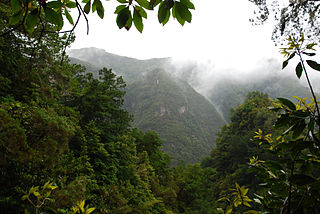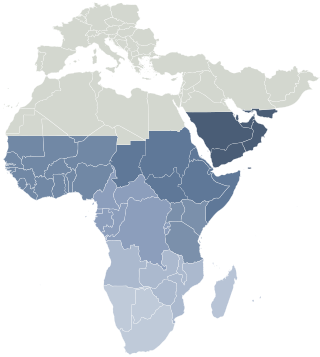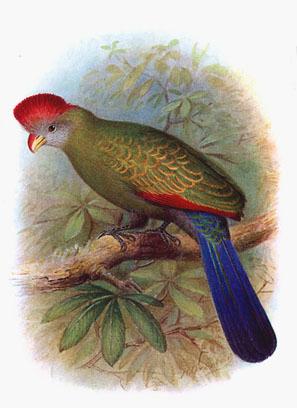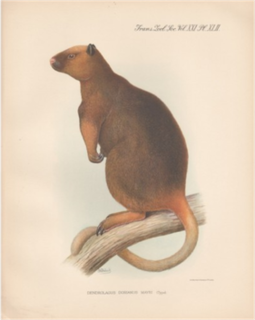
The Northwest Region, or North-West Region is one of ten regions in Cameroon. Its regional capital is Bamenda. The Northwest Region was part of the Southern Cameroons, found in the western highlands of Cameroon. It is bordered to the southwest by the Southwest Region, to the south by the West Region, to the east by the Adamawa Region, and to the north by Nigeria. Various Ambazonian nationalist and separatist factions regard the region as being distinct as a polity from Cameroon.
Bali is an island province of Indonesia.

Laurel forest, also called laurisilva or laurissilva, is a type of subtropical forest found in areas with high humidity and relatively stable, mild temperatures. The forest is characterized by broadleaf tree species with evergreen, glossy and elongated leaves, known as "laurophyll" or "lauroid". Plants from the laurel family (Lauraceae) may or may not be present, depending on the location.

The Cameroon line is a 1,600 km (990 mi) chain of volcanoes. It includes islands in the Gulf of Guinea and mountains that extend along the border region of eastern Nigeria and the West Region of Cameroon, from Mount Cameroon on the Gulf of Guinea north and east towards Lake Chad. The islands, which span the equator, have tropical climates and are home to many unique plant and bird species. The mainland mountain regions are much cooler than the surrounding lowlands, and also contain unique and ecologically important environments.

The Cameroonian Highlands forests, also known as the Cameroon Highlands forests, are a montane tropical moist broadleaf forest ecoregion located on the range of mountains that runs inland from the Gulf of Guinea and forms the border between Cameroon and Nigeria. This is an area of forest and grassland which has become more populous as land is cleared for agriculture.

The wildlife of Cameroon is composed of its flora and fauna. Bordering Nigeria, it is considered one of the wettest parts of Africa and records Africa's second highest concentration of biodiversity. To preserve its wildlife, Cameroon has more than 20 protected reserves comprising national parks, zoos, forest reserves and sanctuaries. The protected areas were first created in the northern region under the colonial administration in 1932; the first two reserves established were Mozogo Gokoro Reserve and the Bénoué Reserve, which was followed by the Waza Reserve on 24 March 1934. The coverage of reserves was initially about 4 percent of the country's area, rising to 12 percent; the administration proposes to cover 30 percent of the land area.

Although tropical Africa is mostly familiar to the West for its rainforests, this biogeographic realm of Africa is far more diverse. While the tropics are thought of as regions with hot moist climates, which are caused by latitude and the tropical rain belt, the geology of areas, particularly mountain chains, and geographical relation to continental and regional scale winds impact the overall areas, also, making the tropics run from arid to humid in West Africa. The area is currently experiencing the negative effects of rapid human population growth.
Cardioglossa melanogaster is a species of frog in the family Arthroleptidae. It is found in the mountains of western Cameroon and eastern Nigeria. Common name Amiet's long-fingered frog has been coined for it.

Bannerman's turaco is a species of bird in the family Musophagidae. It is endemic to Cameroon. In French it is known as touraco de Bannerman or touraco doré. Its scientific and common names honour the ornithologist David Armitage Bannerman. Its natural habitat is subtropical or tropical moist montane forests. It is threatened by habitat destruction and the International Union for Conservation of Nature has listed it as an "endangered species".

The wildlife of São Tomé and Príncipe is composed of its flora and fauna. São Tomé and Príncipe are oceanic islands which have always been separate from mainland West Africa and so there is a relatively low diversity of species, restricted to those that have managed to cross the sea to the islands. However the level of endemism is high with many species occurring nowhere else in the world.
Melicope paniculata, the Lihue melicope, is a rare species of tree in the family Rutaceae. It is endemic to the Hawaiian Islands. Like other Hawaiian Melicope, this species is known as alani.
Vepris suaveolens, synonym Oricia suaveolens, is a species of plant in the family Rutaceae. It is found in Cameroon, the Central African Republic, the Democratic Republic of the Congo, Ivory Coast, Ghana, Guinea, Liberia, Nigeria, and Sierra Leone. It is threatened by habitat loss.
Vepris glaberrima, synonym Oriciopsis glaberrima, is a species of plant in the family Rutaceae. It is native to Cameroon, the Central African Republic, the Republic of the Congo and Gabon. It is threatened by habitat loss.
Vepris heterophylla is a species of plant in the family Rutaceae. It is found in Burkina Faso, Cameroon, Ghana, and Mali. It is threatened by habitat loss.

Xylopia africana is a species of plant in the Annonaceae family. It is found in west-central Africa. It is restricted to submontane and lower montane forests. It is threatened due to habitat loss by clearance of forest. It was first described as Melodorum africanum in 1862 by George Bentham.

Mount Oku, or Kilum Mountain, is the largest volcano in the Oku Massif, in the Cameroon Volcanic Line, located in the Oku region of the Western High Plateau of Cameroon. It is the second highest mountain in mainland Central Africa. The stratovolcano rises to 3,011 metres (9,879 ft) above sea level, and is cut by a large caldera.

The Bakossi Forest Reserve is a 5,517 square kilometres (2,130 sq mi) reserve within the Bakossi Mountains in Cameroon, home to many rare species of plants, animals and birds. The Forest Reserve in turn contains the Bakossi National Park, created by a decree in early 2008. The park covers 29,320 hectares, and was justified on the basis of preserving plant diversification.
Melicope degeneri is a rare species of flowering plant in the family Rutaceae known by the common names Kokee Stream melicope and Degener's pelea. It is endemic to Hawaii, where it is known only from the island of Kauai. It is a federally listed endangered species of the United States. Like other Hawaiian Melicope, this species is known as alani.
The Bamenda pygmy shrew is a terrestrial species of shrew described by Hutterer, Riegert and Sedláček in 2009. It was first discovered during a Museum Koenig expedition to the Bamenda Highlands of Cameroon in 1974, but was not recorded again until 2001, when partial skull remnants were located in the pellets of the endemic African grass owl.

The Wondiwoi tree-kangaroo is a critically endangered, bear-like mammal native to tropical mountain forests on the island of New Guinea. Elusive and rare, it was considered extinct until rediscovery in 2018. It is a species of tree-kangaroo, a group of long-tailed, bear-like animals native to Australia and New Guinea that mostly live in trees and feed on plant matter. Tree-kangaroos belong to the macropod family (Macropodidae) with kangaroos, and carry their young in a pouch like other marsupials. The Wondiwoi tree-kangaroo is likely threatened by hunting, and is known only from remote mountains on the Wondiwoi Peninsula in northwest New Guinea.












